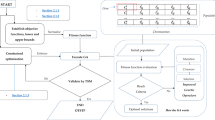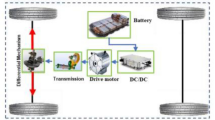Abstract
In order to effectively solve the contradiction between supply and demand of road transportation and avoid waste of road facilities and construction resources, a scientific and systematic road network plan must be formulated. OD traffic flow reflects the distribution of traffic volume from the start point to the end point in the road network for a period of time. The purpose of this paper is to design and simulate a road transport optimization control system based on OD prediction information. This paper first converts the objective function of the variable speed multi-objective optimization model, and then determines the fitness function corresponding to each objective function. Then the linear normalization method is used to normalize the fitness function, and then the judgment matrix is established, and the weights are calculated by the square root method. Transform multi-objective optimization solutions into single-objective optimization solutions. Then the binary value of the decision variable speed limit value is encoded. Finally, crossover probability, mutation probability and genetic algorithm termination evolution algebra were determined. On this basis, the solution method of the optimal speed limit value is provided. After the variable speed limit was implemented for road transportation, the average speed value during peak hours increased from 82.0 to 85.9 km/h, an increase of 3.9 km/h; during the peak period, the vehicle speed increased from 83.3 to 85.6 km/h, an increase 2.3 km/h. The experimental data shows that the variable speed limit control strategy in the road transport optimization control system based on the OD prediction information has a significant effect on improving the driving efficiency of the fast lane.




Similar content being viewed by others
References
Chand HV, Karthikeyan J (2017) Recent survey on traffic optimization in intelligent transportation system. J Adv Res Dyn Control Syst 9(15):89–100
Zhang B, Guo G, Wang LY et al (2018) Vehicle speed planning and control for fuel consumption optimization with traffic light state. Zidonghua Xuebao/Acta Autom Sin 44(3):461–470
Besselink B, Turri V, Hoef SHVD et al (2016) Cyber-physical control of road freight transport. Proc IEEE 104(5):1128–1141
Lee H, Lee B (2018) Path planning based on probabilistic roadmap for initial deployment of marsupial robot team. J Inst Control 24(1):80–89
Kaddoura I, Nagel K (2019) Congestion pricing in a real-world oriented agent-based simulation context. Res Transp Econ 74(MAY):40–51
Zhang L, Wu WM, Huang XW (2016) A dynamic optimization model for adjacent signalized intersection control systems based on the stratified sequencing method. J Highway Transp Res Dev 10(1):85–84
Shengdong M, Zhengxian X, Yixiang T (2019) Intelligent traffic control system based on cloud computing and big data mining. IEEE Trans Ind Inform (99):1–1
Jovanovic A, Nikolic M, Teodorovic D (2017) Area-wide urban traffic control: a Bee Colony Optimization approach. Transp Res Part C Emerg Technol 77(APR.):329–350
Silva FA (2018) Modern electric, hybrid electric, and fuel cell vehicles, third edition [Book News]. IEEE Ind Electron Mag 12(4):46–48
Abe A, Iwamoto K, Okafuji Y et al (2016) Guidance and control system using constrained adaptive backstepping method for space transportation. Proc Inst Mech Eng Part G J Aerospace Eng 230(g11):2063–2076
Wang Y, Yue J, Dong Y et al (2016) Review on kernel based target tracking for autonomous driving. J Inf Process 24(1):49–63
Chiou S-W (2018) A traffic-responsive signal control to enhance road network resilience with hazmat transportation in multiple periods. Reliab Eng Syst Saf 175(JUL.):105–118
Xiong G, Shen D, Dong X et al (2017) Parallel transportation management and control system for subways. IEEE Trans Intell Transp Syst 18(7):1974–1979
Babaki A, Vaez-Zadeh S, Zakerian A (2019) Performance optimization of dynamic wireless EV charger under varying driving conditions without resonant information. IEEE Trans Veh Technol 68(11):10429–10438
Bichiou Y, Rakha HA (2019) Developing an optimal intersection control system for automated connected vehicles. IEEE Trans Intell Transp Syst 20(5):1908–1916
Han K, Liu H, Gayah VV (2016) A robust optimization approach for dynamic traffic signal control with emission considerations. Transp Res Part C 70(sep.):3–26
Tan D, Lu C (2016) The influence of the magnetic force generated by the in-wheel motor on the vertical and lateral coupling dynamics of electric vehicles. IEEE Trans Veh Technol 65(6):4655–4668
Manasra H, Toledo T (2019) Optimization-based operations control for public transportation service with transfers. Transp Res 105(AUG.):456–467
Ye BL, Wu W, Li L et al (2016) A hierarchical model predictive control approach for signal splits optimization in large-scale urban road networks. IEEE Trans Intell Transp Syst 17(8):2182–2192
Wang Y, Liu Z (2019) Equilibrium and optimization in a double-ended queueing system with dynamic control. J Adv Transp 2019(PT.2):6538265.1–6538265.13
Koehler S, Viehl A, Bringmann O et al (2017) Energy-efficiency optimization of torque vectoring control for battery electric vehicles. IEEE Intell Transp Syst Mag 9(3):59–74
Lin Y, Yin K, Dang Y et al (2019) Spatio-temporal LSTM for OD passenger demand prediction. Bjing Jiaotong Daxue Xuebao/J Bjing Jiaotong Univ 43(1):114–121
De Clercq O, Hoste V (2016) All mixed up? Finding the optimal feature set for general readability prediction and its application to English and Dutch. Comput Lingus 42(2):1–35
Alliod C, Chemelle JA, Jacob G et al (2016) ames test prediction on high energy molecules by on-the-Fly QSAR (OTF-QSAR). Propellants Explos Pyrotech 42(1):24–35
Yao B, Yu B, Hu P et al (2016) An improved particle swarm optimization for carton heterogeneous vehicle routing problem with a collection depot. Ann Oper Res 242(2):303–320
Zhao N, Schofield N, Niu W (2017) Energy Storage System for a Port Crane Hybrid Power-Train. IEEE Trans Transp Electr 2(4):480–492
Osorio C, Wang C (2017) On the analytical approximation of joint aggregate queue-length distributions for traffic networks: a stationary finite capacity Markovian network approach. Transp Res Part B Methodol 95(JAN.):305–339
Wai RJ, Yao JX, Lee JD (2017) Backstepping fuzzy-neural-network control design for hybrid maglev transportation system. IEEE Trans Neural Netw Learn Syst 26(2):302–317
Author information
Authors and Affiliations
Corresponding author
Additional information
Publisher's Note
Springer Nature remains neutral with regard to jurisdictional claims in published maps and institutional affiliations.
Rights and permissions
About this article
Cite this article
Chen, S. Highway transportation optimization control system based on OD forecast information. Int J Syst Assur Eng Manag 12, 748–756 (2021). https://doi.org/10.1007/s13198-021-01071-5
Received:
Revised:
Accepted:
Published:
Issue Date:
DOI: https://doi.org/10.1007/s13198-021-01071-5




